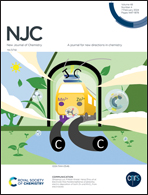High-performance asparagine-modified graphene oxide membranes for organic dyes and heavy metal ion separation†
Abstract
Graphene oxide (GO) lamellar membranes have attracted a lot of attention as a possible solution for water purification applications. In this work, asparagine amino acid-modified GO-based membranes (As@GO) are prepared with different thicknesses. The as-prepared As@GO-based membranes are used for the separation of organic dyes and heavy metal ions. The 300 nm-thick As@GO multilayer membrane shows high rejection, i.e., 99.8% and 99.9% of methylene blue (MLB) and rhodamine B (RB) dyes, respectively, along with an exceptional water permeability of ∼1740 ± 10 L m−2 h−1 bar−1. Furthermore, the As@GO membrane also demonstrates excellent rejection of up to 95.6% and 96.7% for cadmium (Cd2+) and lead (Pb2+) ions, respectively. These membranes are also highly stable in water for up to 34 days and do not swell. These results suggest the valuable experimental basis for the design and development of stable GO membranes (GOMs) with high permeability and superior separation selectivity for applications in the separation fields of valuable metal ion extraction from seawater and other wastewater purification, etc.



 Please wait while we load your content...
Please wait while we load your content...